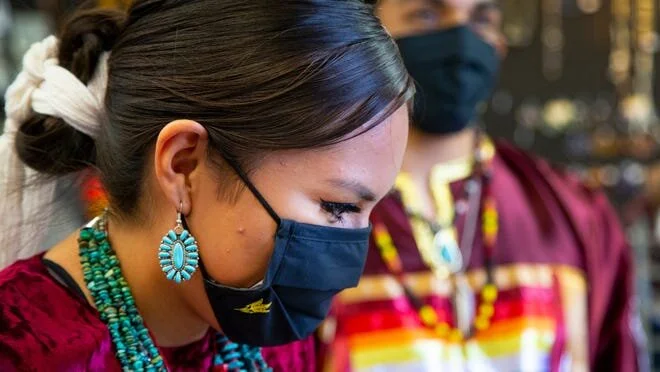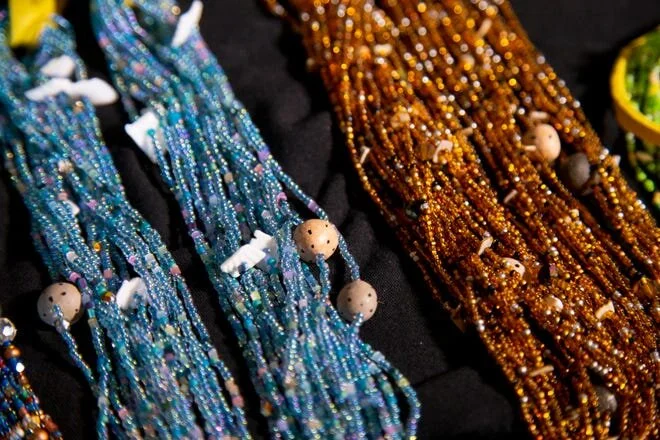Native regalia reflects tribal cultures and histories: 'You remember where you come from'
Savannah Nelson, Dine, Miss Indian ASU First Attendant, and Gabriel Garcia, Tohono O'odham, Mr. Indian ASU First Attendant, shop for gifts at Drumbeat in Phoenix.
Yolanda Hart Stevens straddles an upright mesquite log with an indentation cut into one end.Into the hollowed-out divot, she places hunks of clay dug up from a secret clay pit.
Using the end of an oblong stone about 8 inches long, she pounds the small nodules into a coarse flour-like substance. She sifts pebbles and other contaminants from the pasty clay flour, then adds water and mixes it by hand.
Once it reaches the desired consistency, Hart Stevens pinches off small bits and rolls each into a tiny sphere, poking a paper clip through the clay ball to make a hole. Dozens of the small beads will be fired in a kiln outside her home on the west side of the Gila River Indian Community and strung together with glass beads and other tiny treasures to form a necklace.
Hart Stevens, who’s of the Pee Posh, also known as Maricopa, and Quechan tribes, is carrying on a centuries-long tradition of creating articles of clothing, headpieces, necklaces and earrings, and other items used in Indigenous regalia.
"As small or insignificant as they are, there's a lot of power in those beads in the bead making itself," said Hart Stevens as she strings the completed clay beads alongside shell and colorful glass beads. "A friend of mine refers to a necklace she got from me as her heartbeat because they lay right on her heart."
Whether used for ceremonies within the community, public events like powwows and dances, or for other events, regalia holds deep meaning for the tribal artisans who craft the pieces and the tribal members who wear them.
For millennia, Indigenous peoples have used materials from their surroundings to create both everyday apparel and items for culturally significant events. They range from coming-of-age ceremonies like the Kinaaldá in the Navajo Nation or the Apache Sunrise Dance to more public events such as powwows or the Hoop Dance. But all tribal regalia traces origins to the traditional ways of Native people
Clothing marks community, gender and life transition
Shaliyah Ben said it’s important to put the meaning of “traditional” into context.
“In these modern times 'traditional' points to a past period of time,” said Ben, who is Diné and a member of the Navajo Nation.
But as the tradition continues to play a vital role in tribal communities, so do the items Native people make for themselves, their family and friends to carry on those ways.
“Regalia holds a deeper significance when it becomes a way for one to protect oneself, demonstrate to deities and holy people that you are adorning yourself to make them proud,” said Ben, the Native American arts program coordinator at Idyllwild Arts in Idyllwild, Calif. “This is where you see the various and numerous different styles that make our regalia beautiful and sacred.”
Ben said each tribal community’s clothing reflected their environment.
“In the colder mountainous areas, you see people dressing with more layers and using hides,” she said. “In the Sonoran Desert and Colorado River areas you have people dressing for a warmer environment with more exposure for comfort.”
She said the uniqueness of dress styles is impressive.
“People in the Valley of the Sun had cotton on hand to make garments with,” said Ben. Women also made skirts with bark beaten down to a soft texture, or from tule or other grasses along the Colorado River. “In the traditional sense, regalia is about comfort and function,” she said.
And, Ben said, regalia is regarded as sacred because many tribal creation stories are depicted on the pieces.
Those items of clothing define a Native person as a member of a particular culture, said art educator and curator Nina Sanders.
“Our regular clothing is something that we wear to participate in Western society,” she said. “However, it's our traditional clothing that defines us. We know who you are by what you wear.”
For example, a woman’s elk teeth dress design indicates which family a girl or woman came from, who her mother was, and what family she married into.
Yolanda Hart Stevens, Pee Posh artist, makes native jewelry at her home in the Gila River Indian Community. The dots on the clay beads signifies it is a woman's neckless.
Clothing also marks life transitions.
“When we come to this earth, the first thing that you're adorned with is a blanket that was made for you by your family,” she said. The baby’s cradleboard also proclaims the baby’s gender. “When that person dies, he or she is buried in their regalia as they make their journey to the next place.”
Native people take any opportunity to don their tribal regalia. “It’s a way that we communicate our identity the way that we understand and participate in life transitions,” said Sanders, a member of the Crow Tribe or Apsáalooke, from Montana and the Northern Plains.
“Clothing and personal wear doesn't hold as much significance for non-Indians as it does for us in our thriving and still existent cultures,” said Ben. “What we wear says a lot about who we are, our family and communities.”
Contemporary regalia, traditional roots
Before contact with Europeans, Native people created their clothing and special items completely by hand. Shell beads were painstakingly crafted using hand drills. Bark and tule was harvested, scraped and woven. Buckskin had to be tanned and prepared for use in pants, vests, footwear and for special dresses. Some pieces took hundreds of hours to complete, and those special items were passed down through generations, said Ben.
Some items today still take time. Hart Stevens said the process to dig out clay, pound it, shape it into beads or other shapes, glaze before or after firing, all take up to two weeks to complete. Although beads are largely store-bought Czech or Japanese glass beads, beadwork still takes the same amount of time as in historic times.
Contemporary tribal regalia use not only cloth that harks back to early trade cloth, but bright ribbons, sequined fabrics, rhinestone-embellished rick rack, glass or stone beads. Animal materials like wool and skins, and in some tribes’ cases, bone or horn are still used.
“It’s an expensive endeavor because you want the best beads, best cuts of buckskin and other materials,” Ben said. Hours of work and technical skill are necessary as well in addition to the attention the maker needs to take in the spirit in which they work. “It’s not mass-produced, it’s created in love and reverence for whoever wears the piece.”
In Mesa, a scion of one of Indian Country’s best-known intertribal dance groups uses modern means and materials to craft regalia for use in powwows, dance performances or competitions or for other use.
Kevin Duncan is a member of the Yellow Bird Indian Dancers, a multi-generational troupe. Duncan, who has Arikara, Hidatsa and Apache heritage, has spent his spare time since childhood creating outfits.
“I was literally a terror in the house,” he said. “I would take people’s clothes apart, and I would figure out how to make them by recreating them with hot glue or whatever.”
Finally, his parents gave him a sewing machine, and Duncan learned how to thread it and make stitches.
He draws inspiration from his own tribal backgrounds — both the Northern Plains of his mother’s tribes and his father’s San Carlos Apache homeland — to create his regalia. “It’s like a mix-match of Northern New South,” he said.
Duncan also makes regalia for other people, using their own heritage as a guide. Whether from the Southwest, Northern Plains with their floral motifs, the Eastern tribes or Seminoles with their patchwork outfits, “we can tell where a Hoop Dancer is from by their regalia,” he said.
“And that's very important with your identity, that you remember where you come from and that people are able to recognize you when you're out there in the dance arena," he said.
Ben, who managed the World Championship Hoop Dance Contest at the Heard Museum for several years, said the work of Duncan and other designers of Native regalia and clothing reflects contemporary ways of expressing Native identity.
“We clearly see that we continue as Indigenous people as we draw from our traditional clothing ways and make creative unique spins on them,” she said.
T-shirts made by Native people sporting designs from their communities and the high-end fashions created by couturiers like Loren Aragon and Bethany Yellowtail are in demand in Native America along with regalia for intertribal powwows, dances and other events.
Even regalia from pan-Indian events like the powwow, which has its origins in Plains gatherings, has both designs traditional to tribes from the central U.S. and unique designs that come from the traditions of the particular dancer, Ben said.
Traditional regalia also has become regarded as an art form all its own. Museums ranging from Phoenix’s Heard Museum to the Metropolitan Museum of Art in New York City have organized exhibits that showcase 19th- and 20th-century regalia as well as more contemporary outfits and even Indigenous couture.
Sanders was the first Native American curator to organize such an exhibit at the Field Museum in Chicago. “Apsáalooke Women and Warriors” features both older pieces like war shields and regalia loaned by Crow families and in the Field’s collection, and recently crafted pieces such as intricately beaded moccasins.
Regalia sometimes stirs controversy
Back at Gila River, Hart Stevens continues working on her clay beads using a traditional mesquite pounder.
“One of my elders made if for me when she saw I was serious about doing my work,” she said. “The elder told me, ‘I think you're doing the right thing,’” even though Hart Stevens was making beads and not the acclaimed Maricopa red pottery.
Hart Stevens’ work, which includes Quechan beaded collars and necklaces, incorporates organic stone, bone and shell beads as well as glass beads and her clay beads. Hart Stevens also makes the traditional Quechan one-strand necklace, which is a loop of beads about 30 to 40 feet long, that can be worn in a variety of ways. She also makes ribbon skirts and other clothing in the Pee Posh and Quechan styles with her family’s signature motif: the whirling log that resembles a swastika.
She acknowledged that the symbol means different things to others and that some tribes had quit using the whirling log, but the four-sided design means the opposite of what the Nazis intended.
“It has to do with the way that it's designed, that it's going to flow smoothly and that you're going to have some peace, balance and harmony,” she said.
Hart Stevens, who has the whirling log tattooed on herself, said she’s comfortable with using her family’s symbol, and will talk openly with people who question her use of it.
“I used it on my cuff, my purse and dress and different things.” Her grandfather even tattooed both sides of his face with it.
One point on which all Native people agree, though: Tribal regalia is not costumes.
“What we wear is our traditional regalia, even though it’s neon, even though it’s bright,” said Duncan.
“For a non-Indian to wear a headdress or other sacred, design motifs is like saying we don’t exist,” said Ben. “It writes us off like a joke and further dehumanizes and contributes to the erasure of Indigenous peoples.
“If we look in-depth we see that what you wear indeed does matter.”



